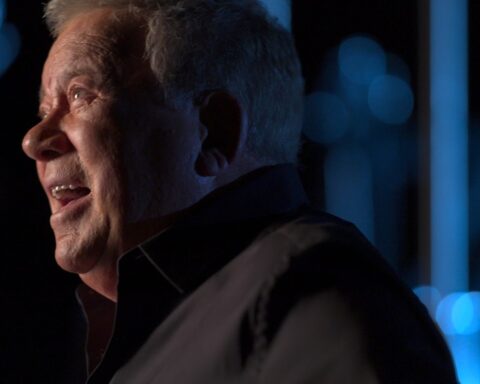Bruce Springsteen’s Letter to You
(USA, 90 min.)
Dir. Thom Zimny
Bruce Springsteen shows no signs of slowing down at the age of 71. His new film Letter to You, which debuts alongside his album of the same name on October 23, proves the Boss as prolific and powerful as ever. Only one year after his film and album Western Stars, Letter to You shows a true icon who embodies the spirit of rock ’n’ roll and makes the most of a rich life, pursuing his passion well into the golden years.
Letter to You follows a formula comparable to Western Stars as it features a complete set of performances with spoken-word interludes in between. However, where Western Stars evokes a reinvention of sorts for Springsteen with its country-tuned harmonies and mellow orchestrations, Letter to You is a return to the Boss’s roots. Similarly, the lyrics of Western Stars reverberate with forward-looking nostalgia. Like the words of a weathered cowboy eyeing the sunset, the previous doc and album suggest an icon who sees what’s ahead but isn’t ready to hand up his boots. There is, however, something poignantly elegiac about Letter to You. Shot in effective black and white and featuring toe-tapping tunes that recall the peak of Springsteen’s work with the E Street Band, the film and the music evoke a sense of finality.
Springsteen unites with his director Thom Zimny, who has documented the rocker’s career quite extensively on film. (Although the Boss got a directing credit alongside Zimny for Western Stars, he gives up the reins, so to speak, this time around.) The relationship between the director and the subject is obviously quite comfortable, as Springsteen seems at ease before the camera. He’s a performer, after all, the Letter to You benefits from his ability as a raconteur as much as a musician.
Letter to You assembles the surviving members of the E Street Band to record the new album with Springsteen. The band includes familiar faces like Steve Van Zandt and, of course, Springsteen’s wife Patti Scialfa, with regulars like Roy Bittan on keyboards and Nils Lofgren on guitar. Newer faces include Jake Clemons, who took over saxophone duties with the E Street Band when Springsteen’s long-time collaborator Clarence Clemons died following complication with a stroke in 2011. The bravado of the late Clemons’ notes are admittedly missed despite his nephew’s firm grip on the ’phone. Also present in spirit is late E Street Band member Danny Federici, whom Charles Giodano replaced on keyboards and the accordion in 2007. While the new additions don’t have the same longevity with the band, the harmony resonates. Highlight tracks like Ghosts could easily be mistaken for releases from their hit albums of the ’80s and ’90s.
Springsteen acknowledges the departed collaborators frequently within the film. As the band records the final takes of the 10-song set, they reminisce about times good and old. However, there’s also a sense that Springsteen and company are aware of the clock and want to make the most of the time they have together. Letter to You is old school rock ’n’ roll, pure and simple, and there is something bittersweet to the nostalgia factor that underscores the recordings. Springsteen and the band opt to record as a collective, rather than perform isolated tracks to be mixed in post-production. These musicians clearly know one another’s grooves and talents, proving that some things are best done the old ways. The spirit of the band also reflects that of an indie upstart collective, rather than a group that’s made millions, as they still clap their own rhythms in lieu of letting some machine set the pace for their tunes.
Springsteen fills in the breaks between musical numbers with reflections about his road to the new album. He humorously reminds the band of a comment that Bob Dylan made about his early songs: “You’re going to use up every word in the English language.” However, while Springsteen’s songs are lean, his rambling and wordy narration, written himself, might have heeded Dylan’s advice. Springsteen’s a great storyteller, but his voiceover in Letter to You sometimes gets lost among the wordy tangents and digressions of the prosaic prose. The Boss doesn’t have the same economy for language writing scripts as he does songs.
However, where the cutaways of Western Stars admittedly feel like filler (Jason Gorber likened them to credit card commercials when reviewing the doc for POV), the interludes complement the retrospective nature of the film. Zimny underscores the nostalgia with some rare archival footage of Springsteen’s early performances. Images of a scrawny and shaggy Springsteen contrast with the more seasoned and polished rocker. These weathered archival images further speak to the longevity of Springsteen’s career, which is no easy feat in the business. The archival snippets also reflect the old-school charm of the new album, since Springsteen reveals that some songs are newly penned tracks, while others were written 50 years ago and are finally getting their proper records.
Letter to You sits comfortably within the nostalgia factory of music docs targeted for audiences of Springsteen’s generation who rocked out to “Born to Run” and “Dancing in the Dark” when they first hit the airwaves. With new songs like “Last Man Standing” and “I’ll See You in My Dreams” holding up to the best of the Boss’s work, the doc rocks as an essay on accepting one’s mortality while living each day to the fullest. If it’s a last hurrah, it’s high endnote.
Bruce Springsteen’s Letter to You debuts on AppleTV+ on October 23.










